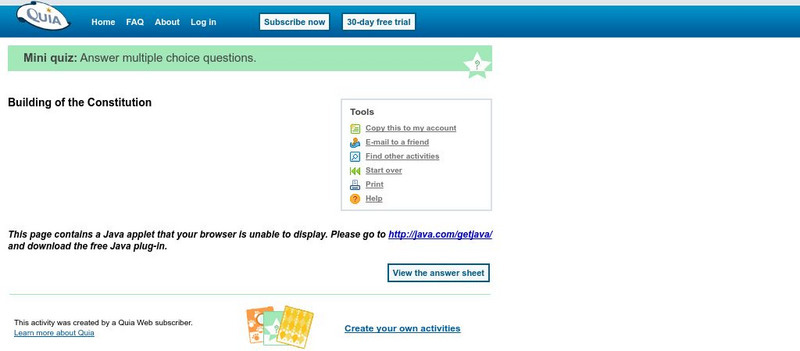E Reading Worksheets
E Reading Worksheets: Patterns of Organization: Compare and Contrast
This learning module provides an explanation of the compare and contrast text structure. An explanation of the compare and contrast text structure is provided, and the compare and contrast text structure is demonstrated in a video...
iCivics
I Civics: Anatomy of the Constitution
This instructional activity gives an article-by-article overview of the structure and function of the U.S. Constitution. Students learn about the duties and powers of the three branches, the amendment process, and the role of the...
E Reading Worksheets
E Reading Worksheets: Patterns of Organization: Order of Importance
This site provides an explanation of the order of importance text structure. A diagram is provided to provide to supplement the explanation.
Grammarly
Grammarly Handbook: Writing a Draft
This page focuses on writing a first draft including getting all the information down in an organized manner without worrying about the grammar and mechanics. It discusses the advantages of using word processing programs which make it...
Grammarly
Grammarly Handbook: Writing Concisely
This page compares wordy writing to a art gallery cluttered with a mixture of great works and poor attempts making it hard to see the great works. Remove the clutter, write concisely so the reader gets the point of the paper. It offers...
Grammarly
Grammarly Handbook: Patterns of Organization for Academic Texts
A list of six different ways to organize a text with links to more information for each.
Thomas Jefferson National Accelerator Facility
Jefferson Lab: Reading Passages: The Three Branches of Government
Read and fill in the blanks of this passage explaining the three branches of government. Each blank has a drop-down menu with choices. When you finish, click CHECK MY ANSWERS. If you pick a wrong answer, the right answer will be...
Other
D'youville College: Core Parts of a Sentence
This online writing lab provides a series of examples on identifying one of the two main components of complete sentences, the subject and the verb. Correctly identifying these parts will result in the ability to write complete sentences.
Other
Critical Reading: Subject and Predicate
Part of a larger site on "The Fundamentals of Critical Reading and Effective Writing," this section on the simple sentence focuses on the subject and the predicate. Definitions and examples are provided along with a section on...
Other
Troubleshooting Sentences
This site presents in chart form a list of common sentence problems with possible solutions offered. A couple additional links are provided for further information.
Other
Wilfrid Laurier University: Paragraph Writing [Pdf]
This site from the Wilfrid Laurier University provides a complete guide to paragraph writing. Contains many examples along with details and structures that are often left out when students write.
Other
Yukon College: Reading & Writing Academic Articles [Pdf]
This detailed guide provides background information about the purpose and structure of journal articles, then walks the reader step-by-step through the reading process. Additional resources are included.
Grammarly
Grammarly Handbook: Body of the Text
This page explains how to write the body of the text from your outline (a link to "How to Write an Outline" is provided). The body must support the thesis and provide evidence and examples to support the thesis.
Grammarly
Grammarly Handbook: Headings
This page focuses on the use of headings in a paper. The layout of the headings and subheadings should be determined before beginning the paper to make it easier to read and more attractive. Most important is to be consistent with...
Grammarly
Grammarly Handbook: The End
A list of text requirements that may be necessary after the conclusion of a research paper.
Grammarly
Grammarly Handbook: Where to Find Information
This page focuses on where to find information needed for writing papers: the library or the internet. It offers tips for using search engines and key words.
Grammarly
Grammarly Handbook: Primary, Secondary, or Tertiary Resources
Definitions and examples of primary, secondary, and tertiary resources.
ReadWriteThink
Read Write Think: Power Notes
A printable note-taking format where students create an outline by assigning powers to the main idea and supporting details. Directions on how to use this type of rubric as well as lists of teaching ideas and related resources are also...
Grammarly
Grammarly Handbook: Organize Your Thoughts in Patterns
Tips on organizing ideas in an essay.
Quia
Quia: The Articles of Confederation and the Writing of the Constitution
Take a quiz on the Articles of Confederation and the writing of the Constitution.
Quia
Quia: Building of the Constitution
Quiz yourself on how well you know the events leading up to writing the United States Constitution.
City University of New York
College of Staten Island Library: How to Write an Essay
Resource defines what an essay is, the parts of an essay and their functions, and also discusses the editing process and how important it is to check a draft for completeness and high quality. Includes a link to an online guide to citing...
University of Calgary
University of Calgary: Basic Elements of English
Sections include parts of speech, sentence elements, punctuation, and word use. Also includes a "brief explanations of common writing errors." The tutorials also include interactive quizzes to check your understanding.









